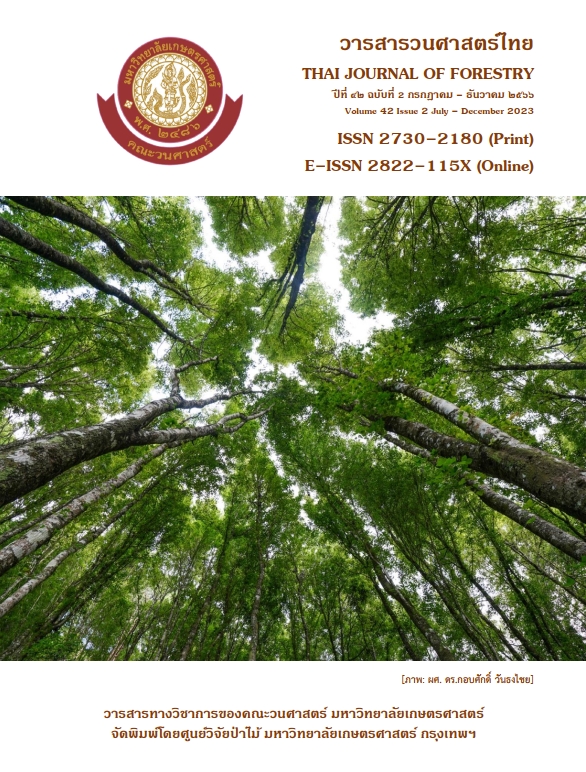มูลค่าการใช้ประโยชน์ของป่าในป่าชุมชนบ้านปางสวรรค์ ตำบลคอกควาย อำเภอบ้านไร่ จังหวัดอุทัยธานี
Main Article Content
บทคัดย่อ
การศึกษาครั้งนี้มีวัตถุประสงค์เพื่อศึกษาข้อมูลทางเศรษฐกิจและสังคม มูลค่าการใช้ประโยชน์จากของป่าและการแปรรูปของป่าเป็นสินค้าของราษฎรที่อาศัยอยู่ในชุมชนบ้านปางสวรรค์ ตำบลคอกควาย อำเภอบ้านไร่ จังหวัดอุทัยธานี โดยใช้แบบสัมภาษณ์ในการเก็บข้อมูลหัวหน้าครัวเรือนที่อาศัยอยู่บ้านปางสวรรค์ทั้งหมด จำนวน 94 ครัวเรือน หรือผู้แทนครัวเรือนวิเคราะห์ด้วยสถิติเชิงพรรณนา ได้แก่ ค่าความถี่ ค่าร้อยละ ค่าต่ำสุด ค่าสูงสุด และค่าเฉลี่ย
ผลการศึกษาพบว่า ราษฎรที่มีการใช้ประโยชน์จากป่าชุมชนบ้านปางสวรรค์ ส่วนใหญ่เป็น เพศชาย ร้อยละ 67.0 มีอายุเฉลี่ย 51.7 ปี จบการศึกษาระดับประถมศึกษา ร้อยละ 58.5 ประกอบอาชีพหลักเกษตรกรรม ร้อยละ 51.1 รายได้เฉลี่ย 139,825.70 บาทต่อปี มีรายจ่ายเฉลี่ย 103,881.80 บาทต่อปี ราษฎรมีหนี้สิน ร้อยละ 46.8 ของรายได้ และมีที่ดินเฉลี่ย 5.7 ไร่ มีการเก็บหาของป่ามาใช้ประโยชน์ทั้งสิ้น 10 ประเภท ได้แก่ ไม้ฟืน ไม้ไผ่ หน่อไม้ผลไม้ป่า พืชผักป่า เห็ด พืชกินหัว แมลงและผลผลิตจากแมลง สัตว์ขนาดเล็ก และสมุนไพร มีมูลค่าสุทธิทั้งหมด 632,653.50 บาทต่อปี หรือ 6,730.50 บาทต่อปีต่อครัวเรือน โดยเห็ดมีมูลค่าสุทธิสูงสุด 202,547.00 บาทต่อปี หรือ 2,154.80 บาทต่อปีต่อครัวเรือน ราษฎรร้อยละ 34.0 มีปัญหาและอุปสรรคในการเก็บหาของป่า ราษฎรมีการแปรรูปของป่า ร้อยละ 43.6 โดยแปรรูปเป็นถ่าน หน่อไม้ดอง และเห็ดโคนดองน้ำปลา มีมูลค่า 12,424.80, 86,170.00 และ 40,000.00 บาทต่อปี ตามลำดับ สำหรับใช้ในครัวเรือน และเพื่อจัดจำหน่าย ดังนั้นหน่วยงานของรัฐควรส่งเสริมการแปรรูปของป่าเพิ่มขึ้นเพื่อใช้ประโยชน์ในครัวเรือน และเพื่อเป็นรายได้เสริมให้กับครัวเรือน
Downloads
Article Details

อนุญาตภายใต้เงื่อนไข Creative Commons Attribution-NonCommercial-NoDerivatives 4.0 International License.
ข้าพเจ้าและผู้เขียนร่วม (ถ้ามี) ขอรับรองว่า ต้นฉบับที่เสนอมานี้ยังไม่เคยได้รับการตีพิมพ์และไม่ได้อยู่ในระหว่างกระบวนการพิจารณาตีพิมพ์ลงในวารสารหรือสิ่งตีพิมพ์อื่นใด ข้าพเจ้าและผู้เขียนร่วม (ถ้ามี) ยอมรับหลักเกณฑ์และเงื่อนไขการพิจารณาต้นฉบับ ทั้งยินยอมให้กองบรรณาธิการมีสิทธิ์พิจารณาและตรวจแก้ต้นฉบับได้ตามที่เห็นสมควร พร้อมนี้ขอมอบลิขสิทธิ์ผลงานที่ได้รับการตีพิมพ์ให้แก่วารสารวนศาสตร์ คณะวนศาสตร์ มหาวิทยาลัยเกษตรศาสตร์ กรณีมีการฟ้องร้องเรื่องการละเมิดลิขสิทธิ์เกี่ยวกับภาพ กราฟ ข้อความส่วนใดส่วนหนึ่ง หรือ ข้อคิดเห็นที่ปรากฏในผลงาน ให้เป็นความรับผิดชอบของข้าพเจ้าและผู้เขียนร่วม (ถ้ามี) แต่เพียงฝ่ายเดียว และหากข้าพเจ้าและผู้เขียนร่วม (ถ้ามี) ประสงค์ถอนบทความในระหว่างกระบวนการพิจารณาของทางวารสาร ข้าพเจ้าและผู้เขียนร่วม (ถ้ามี) ยินดีรับผิดชอบค่าใช้จ่ายทั้งหมดที่เกิดขึ้นในกระบวนการพิจารณาบทความนั้น”
เอกสารอ้างอิง
Community Forestry Center for People and Forests. 2017. Community Resource Base at Baan Pang Sawan, Khok Kwai Sub–district, Ban Rai District, Uthai Thani Province. Community Forestry Center for People and Forests, UthaiThani, Thailand. (in Thai).
Houmuangkeaw, W. 2014. Forest Resource Economics. Aksornsiam Printing, Bangkok, Thailand. (in Thai).
Petchdee, T., Suksard, S. 2018. Non–timber Forest Products Utilization value at Nong Khoo Silvicultural Research Station Surin province. Thai Journal of Forestry, 37(2): 99–107. (in Thai).
Puangmalee, J. 2013. Use Value of Non–timber Forest Products at Ban Khao Khew Community Forest, Hua Khao Sub–district, Doem Bang Nang Buat District, Suphan Buri Province. M.S. Thesis, Kasetsart University, Thailand. (in Thai).
Puangmalee, J., Suksard, S., 2014. Use value of non–timber forest products at Khao Khew Community Forest, Hua Khao sub–district, Doem Bang Nang Buat district, Suphan Buri province. Thai Journal of Forestry, 33(1): 76–84. (in Thai).
Royal Forest Department. 1988. Community Forest Management. Veterans Affairs Printing House, Bangkok, Thailand. (in Thai).
Suksard, S. 2006. Forest Valuation. Department of Forest Management, Faculty of Forestry, Kasetsart University, Bangkok, Thailand. (in Thai).


